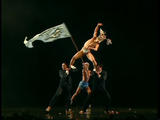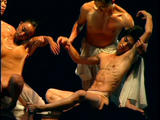
 Nine.Songs.(Cloud.Gate.Dance.Theatre,.Lin.Hwai-min,.1995).DVDRip.avi [700.88 Mb]
Nine.Songs.(Cloud.Gate.Dance.Theatre,.Lin.Hwai-min,.1995).DVDRip.avi [700.88 Mb] 

A dazzlingly colorful folklore work by Cloud Gate Theatre (in many ways, a direct opposite of the austere expressionism dominating Portraits of the Families). Watch it: it's sensuous and... hot! I can hardly think of a dance performance more appropriate to be seen in springtime.



CLOUD GATE DANCE THEATRE
NINE SONGS
Choreography Lin Hwai-min
Music Indigenous music of Taiwan, traditional music of Asia, and percussion score by the Ju Percussion Group
Set Design Ming Cho Lee
Lighting Design Lin Keh-hua
Costume Design Lin Hwai-min
Lo Ruey-chi
Mask Design Lin Shu-feng
Wang Yao-chun
Slide Design Chang Huei-wen
Technical Design Richard Loula
Calligraphy Tong Yang-tzu
Premiere
August 10, 1993, at National Theatre, Taipei, Taiwan.
And yet the gods have never come...
Greeting the Gods
Homage to the Sun God
Homage to the Gods of Fate
---20 minutes intermission---
Homage to the Goddess of the Xiang River
Homage to the God of the Clouds
Homage to the Mountain Spirit
Homage to the Fallen
Honoring the Dead
110 minutes excluding intermission
AND YET THE GODS HAVE NEVER COME...
"Nine Songs", or Jiu Ge, were written more than 2,400 years ago by Qu Yuan, one of the greatest Chinese poets. They have since come to represent the epitome of classical Chinese literature.
The songs, actually poems, were adapted from a series of ritual verses. There are actually eleven "songs" in Qu's cycle of poems (in Chinese, the word "nine" often simply means many). Nine of the songs address various gods and goddesses, a tenth honors the spirit of warriors killed in battle, and the last is a short hymn or recessional. The verses speak of life, of nature, of love unfulfilled, of the dark hours of loneliness, and of an honorable death. Throughout the cycle, the poet laments the fact that the gods fail to appear, or that they appear and quickly vanish.
In the ancient rituals in which these songs were originally sung, shamans would assume the roles of the gods and goddesses, as well as the celebrants. Unfortunately, the music, costumes and dance steps used in these rituals have long been lost.
In Lin Hwai-min's full-length production, the choreographer uses Qu Yuan's Nine Songs as a springboard for creating a contemporary dance drama. He draws on the images of particular gods and goddesses that appear in the poems, but he reinterprets these images, giving them a new dimension that reflects his own concerns about Chinese history and about modern life. The result is a rich interplay of contrasts between classical and contemporary images.
Much as the narrator in Qu Yuan's original poems becomes frustrated by the gods, the dance itself deals with the frustrations of human existence. This frustration builds up to a violent climax, then abruptly moves toward a meditative ending of spiritual calmness.
Like the poems, the dance also reflects the cycles of nature. The first half moves from day to night, from the bright and powerful Sun God to the dark and demoralizing Gods of Fate, who bring manipulation and abuse to the human world. The second half of the dance follows the seasons: Spring arrives with the Goddess of the Xiang River, who gradually becomes a symbol of wasted youth. Summer is represented by the God of the Clouds, whose powerful authority bears down on the two mortals who carry him throughout this section of the dance. In autumn is the lonely dance of the Mountain Spirit, who seems to foresee the pain ahead. Finally, the winter brings death and destruction, and the time to pay homage to those who have suffered and died.
Some of the images in the last two sections, "Homage to the Fallen," and "Honoring the Dead," are inspired by recent Chinese history. They draw, for example, on the Japanese occupation of Taiwan (when those to be executed were led to their deaths with baskets over their heads); on what is known as the "2-28 Incident" (an uprising that began on February 28, 1947, in which thousands of Taiwanese people were executed by the new Chinese government); and on the massacre at Tiananmen Square. During this section, the names of people who were executed or otherwise sacrificed their lives are recited, using Mandarin Chinese, Taiwanese, the Hakka dialect, and the language of the Atayal, an indigenous tribe of Taiwan. The recitation spans the history of China and includes names of ancient heroes as well as those who died in the "2-28 Incident."
The set for Nine Songs also reflects nature's cycle. Set designer Ming Cho Lee has used the lotus as his main motif -- the flower and its huge, full leaves appear in an actual lotus pond at the front of the stage, and the set itself is an enlarged detail of a lotus painting by Taiwanese artist Lin Yu-san. The lotus is a classical Chinese symbol for the cycle of death and rebirth. The flower buds in spring, blossoms in the summer, withers in autumn, and rots in winter -- to return again in the spring. The final image of the dance reflects this hope of rebirth.
(http://www.cloudgate.org.tw/eng/english/pop/nine_songs_text01.htm)


 thank you once again. Downloading since ... yesterday .
thank you once again. Downloading since ... yesterday .
